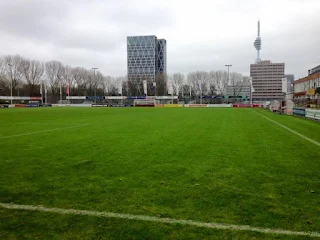Amsterdamsche
Football Club, or AFC as they are more commonly known, is an amateur football
club from Amsterdam. The club was formed on the 18th January 1895, boasting a
rich history. The club was formed as Amsterdam FC following an inaugural meeting in the basement of a house on Koninginneweg.
It was decided to adopt the Amsterdam city colours of red and black, with home games being played between the ponds at Vondelpark and Oranje Nassau Laan. In 1897, the club became a member of the Amsterdamsche Voetbal Bond (AVB), with the team playing in the second tier of Dutch football by 1900. In 1906, AFC moved into a new home, Watergraafsmeer.
The team won their league in 1908-09 but failed to win promotion after a playoff game against Ajax Leiden. Eventually, promotion was achieved in 1916-17 following wins in the play-off round against 't Gooi, Feijenoord, and SVV. In both 1917-18 and 1918-19, AFC won their division but finished in third and then fourth place in the final round in their search to become national champions.
In December 1920, the club moved to Amsterdam-Zuid, at a time which would prove to be difficult for the team. Relegation to the second tier, Overgangsklasse, came in 1921. Worse was to come as AFC went down again the following season to the Tweede Klasse. It was a long wait before fans of the club had anything to celebrate, but it came in the 1945-46 season.
The
deciding championship game against KFC was played at Olympisch Stadion in front
of a huge crowd of 43,000, which AFC won 4-2. However, promotion was not
achieved as the team missed out in the final rounds. The club membership had
grown to 727 by this time.
In 1954-55, the club suffered a further relegation to Derde Klasse, but the leagues were re-organised at this point as professional football began in the Netherlands. The club was placed in the national third-tier Tweede Klasse for amateur clubs. The title was secured in 1961, with AFC moving into their new home, Goed Genoeg, a year later.
Three
Erste Klasse titles arrived at the club in 1962-63, 1966-67, and 1968-69. The middle
title was the closest that AFC came to being crowned national amateur champions, but
they lost out to Middelburg over two legs in the final. Membership in the club
had doubled from the 1946 figure.
Further re-organising of the leagues took place over the years, with AFC going down to Erste Klasse in 1997-98, before returning to Hoofdklasse in 2000-01. The team finished as Zondag Hoofdklasse runners-up in the 2006-07 season. In 2010, AFC won their Hoofdklasse division but could only draw games against De Treffers and Gemert in their bid to be crowned Zondag Hoofdklasse champions.
However, promotion was sealed to the Zondag Topklasse, the third tier of Dutch
football, which has two divisions: one for clubs playing on a Saturday, and one
for Sunday. The lower reaches of Dutch league football were reorganised for the 2016-17 season as AFC were placed in the third-tier Tweede Divisie after a sixth-place in the final campaign of Topklasse.
This was under trainer Bart Logchies before he was replaced by Ton du Chatinier. Amsterdamsche finished just above the drop zone in 2017-18 after experienced coach André Wetzel helped prevent relegation after a steady debut season, before becoming league champions in 2018-19.
However, no promotion was awarded to reward the work of coach Uli Landvreugd and top scorer Raily Ignacio. Sixth place was achieved in 2021-22, which was improved upon as AFC ended third a year later under trainer Benno Nihom.
The performance was replicated in 2024-25 before the appointment of new trainer, Chedric Seedorf, who was a former player of the club.
Amsterdamsche
Football Club will play in the Tweede Divisie in the 2025-26 season.
My
visit
Wednesday
27th January 2016
My
morning was getting better after a good walk and plenty of fresh air. From my
last stop off at the Olympisch Stadium, I’d taken a tram and then the train to
Amsterdam Zuid. A quick walk past the headquarters of ABN AMRO took me to
Beethovenstraat. I was most delighted to see the entrance to Sportpark Goed
Genoeg over the car park.
I’d
grabbed a quick glimpse the previous afternoon as my host Dave Kenwery
collected me from Schipol Airport and drove me to his apartment along the
raised A10 motorway, which bordered the northern side of the ground.
I
found it to be a very neat ground. The far side had a modern-looking
cantilevered stand straddling the middle third of the pitch. The near side had
three rows of steep terraces with wooden bench seating, before giving way to a
large clubhouse and facility block taking up the far half of the touchline.
Either end had a mixture of hard standing and shallow grass banking.
All
open areas had raised advertising to give the ground a real enclosed feel. At
the rear of the main pitch, there were several artificial pitches, with the
main one having dugouts and a single rail fence around it.
As
ever on such a day, I was keeping a close eye on the clock. If I got a move on, it meant that I could catch a direct train to Arnhem, where I was heading for
that evening’s match between Vitesse and PEC Zwolle.
My
path back along the side of the railway and underneath the railway got me back
with enough time to top up my OV Travelcard, which served all of the
Netherlands, and to grab some snacks for the train. I left Amsterdam with a far
better opinion of it than when I had arrived.










No comments:
Post a Comment